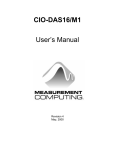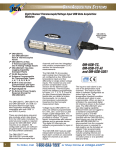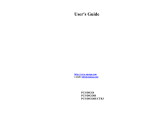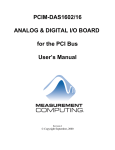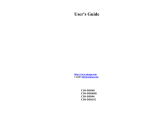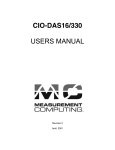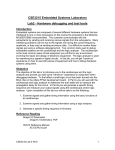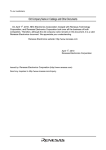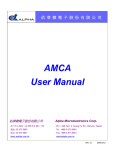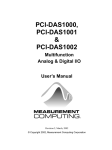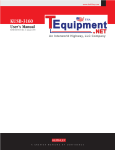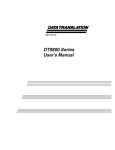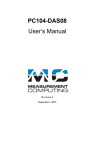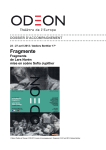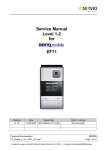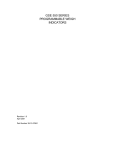Download CIO-DAS16/M1 User`s Manual
Transcript
CIO-DAS16/M1 User’s Manual Revision 4 May, 2000 Your new Measurement Computing product comes with a fantastic extra — Management committed to your satisfaction! Thank you for choosing a Measurement Computing product—and congratulations! You own the finest, and you can now enjoy the protection of the most comprehensive warranties and unmatched phone tech support. It’s the embodiment of our mission: To provide data acquisition hardware and software that will save time and save money. Simple installations minimize the time between setting up your system and actually making measurements. We offer quick and simple access to outstanding live FREE technical support to help integrate MCC products into a DAQ system. Limited Lifetime Warranty: Most MCC products are covered by a limited lifetime warranty against defects in materials or workmanship for the life of the product, to the original purchaser, unless otherwise noted. Any products found to be defective in material or workmanship will be repaired, replaced with same or similar device, or refunded at MCC’s discretion. For specific information, please refer to the terms and conditions of sale. Harsh Environment Program: Any Measurement Computing product that is damaged due to misuse, or any reason, may be eligible for replacement with the same or similar device for 50% of the current list price. I/O boards face some harsh environments, some harsher than the boards are designed to withstand. Contact MCC to determine your product’s eligibility for this program. 30 Day Money-Back Guarantee: Any Measurement Computing Corporation product may be returned within 30 days of purchase for a full refund of the price paid for the product being returned. If you are not satisfied, or chose the wrong product by mistake, you do not have to keep it. These warranties are in lieu of all other warranties, expressed or implied, including any implied warranty of merchantability or fitness for a particular application. The remedies provided herein are the buyer’s sole and exclusive remedies. Neither Measurement Computing Corporation, nor its employees shall be liable for any direct or indirect, special, incidental or consequential damage arising from the use of its products, even if Measurement Computing Corporation has been notified in advance of the possibility of such damages. Trademark and Copyright Information Measurement Computing Corporation, InstaCal, Universal Library, and the Measurement Computing logo are either trademarks or registered trademarks of Measurement Computing Corporation. Refer to the Copyrights & Trademarks section on mccdaq.com/legal for more information about Measurement Computing trademarks. Other product and company names mentioned herein are trademarks or trade names of their respective companies. © 2000 Measurement Computing Corporation. All rights reserved. No part of this publication may be reproduced, stored in a retrieval system, or transmitted, in any form by any means, electronic, mechanical, by photocopying, recording, or otherwise without the prior written permission of Measurement Computing Corporation. Notice Measurement Computing Corporation does not authorize any Measurement Computing Corporation product for use in life support systems and/or devices without prior written consent from Measurement Computing Corporation. Life support devices/systems are devices or systems that, a) are intended for surgical implantation into the body, or b) support or sustain life and whose failure to perform can be reasonably expected to result in injury. Measurement Computing Corporation products are not designed with the components required, and are not subject to the testing required to ensure a level of reliability suitable for the treatment and diagnosis of people. © Copyright 2000, Measurement Computing Corp. HM CIO-DAS16_M1.docII Table of Contents 1. SOFTWARE INSTALLATION .........................................................................................................................................................1 2. HARDWARE INSTALLATION ........................................................................................................................................................1 2.1 BASE ADDRESS ............................................................................................................................................................................1 2.2 USER-COUNTER CLOCK/CHAINING JUMPERS......................................................................................................................2 2.3 PACER CLOCK SOURCE SELECT JUMPER..............................................................................................................................2 2.4 INSTALLING THE CIO-DAS16/M1 IN THE COMPUTER .........................................................................................................3 2.5 PROGRAMMABLE RANGE AND GAIN SETTING ...................................................................................................................3 3. SIGNAL CONNECTIONS..................................................................................................................................................................4 3.1 INTRODUCTION ...........................................................................................................................................................................4 3.2 ANALOG CONNECTOR DIAGRAM............................................................................................................................................4 3.2.1 Analog Inputs ............................................................................................................................................................................5 3.2.2 Connecting Analog Inputs.........................................................................................................................................................5 1.1.3 Shielding ...................................................................................................................................................................................5 1.1.4 Grounded Signal Source ...........................................................................................................................................................5 1.1.5 Floating Signal Source..............................................................................................................................................................6 1.1.6 Avoiding Ground Loops ............................................................................................................................................................6 1.3 DIGITAL OUTPUTS & INPUTS....................................................................................................................................................7 1.3.1 Digital Output Connector .........................................................................................................................................................7 1.3.2 Counter Clock Jumper ..............................................................................................................................................................7 1.3.3 Cabling the Digital Connector..................................................................................................................................................7 4. REGISTER ARCHITECTURE........................................................................................................................................................10 4.1 DATA TRANSFERS .....................................................................................................................................................................10 4.2 FIFO DATA BUFFER...................................................................................................................................................................10 4.3 CHANNEL/GAIN QUEUE ...........................................................................................................................................................10 4.4 CHANNEL/GAIN MEMORY CONTENTS REGISTER .............................................................................................................11 4.5 DT-CONNECT ..............................................................................................................................................................................12 4.6 CONTROL & DATA REGISTERS...............................................................................................................................................12 4.6.1 A/D Data & Channel Registers ...............................................................................................................................................14 4.6.2 Control & Status Bits ..............................................................................................................................................................14 4.6.3 Four-Bit Digital I/O Registers ................................................................................................................................................15 4.6.4 Clear Interrupt Status Register ...............................................................................................................................................16 4.6.5 Interrupt Control, Pacer Source Register ...............................................................................................................................16 4.6.6 Channel Gain Queue Address Register...................................................................................................................................17 4.6.7 Channel Gain Queue Data Register........................................................................................................................................18 4.6.8 Total Counter Data & Control Registers ................................................................................................................................19 4.6.9 Digital I/O and Counter Control & Data Registers ...............................................................................................................20 4.6.10 82C55 Digital I/O Registers..................................................................................................................................................21 4.6.11 COUNTER CHIP (82C54) ....................................................................................................................................................23 5. SPECIFICATIONS............................................................................................................................................................................24 6. ELECTRONICS AND INTERFACING..........................................................................................................................................27 6.1 COMMON MODE.........................................................................................................................................................................27 6.2 COMMON MISUNDERSTANDINGS .........................................................................................................................................28 6.3 GROUND LOOPS .........................................................................................................................................................................28 6.4 PULL UP & PULL DOWN RESISTORS .....................................................................................................................................28 6.5 TTL TO SOLID STATE RELAYS................................................................................................................................................29 6.6 VOLTAGE DIVIDERS .................................................................................................................................................................30 6.7 LOW PASS FILTERS ...................................................................................................................................................................32 iii This page is blank. iv 1. SOFTWARE INSTALLATION The board has a variety of switches and jumpers to set before installing the board in your computer. By far the simplest way to configure your board is to use the InstaCalTM program provided as part of your software package. InstaCalTM will show you all available options, how to configure the various switches and jumpers to match your application requirements, and will create a configuration file that your application software (and the Universal Library) will refer to so the software you use will automatically know the exact configuration of the board. Please refer to the Software Installation Manual regarding the installation and operation of InstaCalTM. The following hard copy information is provided as a matter of completeness, and will allow you to set the hardware configuration of the board if you do not have immediate access to InstaCalTM and/or your computer 2. HARDWARE INSTALLATION The CIO-DAS16/M1 has one bank of base address switches and four jumpers to set before installation of the board in your computer. 2.1 BASE ADDRESS Unless there is already a board in your system which uses address 300h (768 decimal), leave the switches as they are set at the factory. In the example shown in Figure 2-1, the CIO-DAS16/M1 is set for base address 300h. Figure 2-1. Base Address Switch 1 2.2 USER-COUNTER CLOCK/CHAINING JUMPERS The CIO-DAS16/M1 has three counters available to the user at the digital connector, P5. (A fourth counter is available at the analog connector, P1.) The three digital-connector counters are associated with registers Base + 404, +405, and +406. User-Counter 0 can be externally clocked by a jumper at JB2. It is adjacent to the digital connector and connects the internal 10 MHz OSC signal to Counter 0 clock input (Figure 2-2). Using two additional jumpers at JB2, the counters can be chained 0 to1, and 1 to 2 to yield counters of 32 or 48 bits. These counters can also be chained externally at the 40-pin digital connector, P5. JB2 OSC C0 (CLK 0) The on-board 10 MHz OSC signal can be connected directly to the clock of CTR 0 by jumping OSC to C0. O0 (OUT 0) C1 (CLK 1) The output of CTR 0 (O0) can be chained directly to the clock of CTR 1 (C1). O1 (OUT 1) C2 (CLK 2) The output of CTR 1 (O1) can be chained directly to the clock of CTR 2 (C2). Figure 2-2. User-Counter Clock Source and Chaining Jumpers 2.3 PACER CLOCK SOURCE SELECT JUMPER When using the internal clock for pacing, select the desired frequency of the source supplied to the pacer counters by setting the XTAL jumper for either 1 or 10 MHz (Figure 2-3). In most cases, 10MHz is the appropriate choice. Use the 1MHz option only if you are using the CIO-DAS16/M1 with software designed for the DAS16 (which would calculate pacer speed based on a 1MHz sourc to the pacer counters). 1 MHz 10 XTAL Figure 2-3. Pacing Counter Frequency-Select Jumper 2 2.4 INSTALLING THE CIO-DAS16/M1 IN THE COMPUTER 1. Turn the power off. 2. Remove the cover of your computer. Please be careful not to dislodge any of the cables installed on the boards in your computer as you slide the cover off. 3. Locate an empty expansion slot in your computer. If you plan to use the 24 bits of digital or three counters accessible through the rear connector, you should install the board in a slot with an available adjacent slot for the BP40-37 connector-cable-backplate assembly. 4. Push the board firmly down into the expansion bus connector. If it is not seated fully it may fail to work and could short circuit the PC bus power onto a PC bus signal. This could damage the motherboard in your PC or the board. 2.5 PROGRAMMABLE RANGE AND GAIN SETTING The analog input range is fully programmable. There are no switches to set. The board has a channel/gain queue, that is programmed to align a channel and gain in a programmed channel scan sequence. Channel/Gain queue loading is handled by the Universal Library programming language library and by application programs which support the CIO-DAS16/M1. Setting the channel gain queue is required prior to making any measurements with the CIO-DAS16/M1 so the concept of a default range value is meaningless. 3 3. SIGNAL CONNECTIONS 3.1 INTRODUCTION There are three connectors on th CIO-DAS16/M1. The 37-pin connector, P1, on the rear mounting plate is primarily for analog signals. It is referred to as the analog connector. The 40-pin header connector, P5, at the front of the board has 24 digital I/O lines. It also has clock, gate, and output signals for three counters associated with registers Base + 404, +405, and +406. It is referred to as the digital connector. The DT-Connect connector (P4) at the top of the board is included primarily for use with the MEGAFIFO huge sample buffer, which may be required to attain the maximum acquisition rate. 3.2 ANALOG CONNECTOR DIAGRAM The CIO-DAS16/M1 analog connector is a 37-pin, D-type connector accessible from the rear of the PC on the expansion backplate. The connector accepts female 37-pin D-type connectors, such as the C37FF2, a 2-foot cable. The Counter 0 signals are associated with the register at Base + C. The CTR 2 OUT signal is the internal PACER signal (registers at Base + D, +E, and +F.) Figure 3-1. Analog Connector Pin Out If frequent changes to signal connections or signal conditioning is required, please refer to the information on the CIO-MINI37, CIO-TERMINAL, or SCB-37 screw terminal board. 4 3.2.1 Analog Inputs The CIO-DAS16/M1 has eight differential analog input channels. Each channel has a signal-high input and a signal-low input. The measurement made by the A/D is the voltage difference between the LOW and HIGH inputs. Differential inputs have a common mode range (see application note). The CIODAS16/M1 can have as much as 10V of common mode voltage between LLGND and signal LOW. CAUTION Measure the voltage between the ground signal at the signal source and the PC. Use a voltmeter and place the red probe on the PC ground and the black probe on the signal ground. If there is more than 10 volts, do not connect the CIO-DAS16/M1 to this signal source because you will not be able to make any reading. If the voltage is over 20V, DO NOT connect this signal because it will damage the board . 3.2.2 Connecting Analog Inpu ts Connect analog inputs as shown in Figure 3-2 below. Pay close attention to cabling and grounding of the shield. Failure to cable as shown will result in signal noise. NOTE: Failure to cable as recommended will cause less than perfect readings. Perform signal wiring with consideration to the high speeds involved. Even if your A/D pacing rate is not high, the converter is always converting at less than 1µs and the internal MUX switching is done at a similar high speed. NOTE: Keep high and low wires together. Keep the signal wires for a channel together. Ideally, they should be a twisted pair. This will aid the differential inputs in rejecting EMI or RFI from input signals. 3.2.3 Shielding To further protect the input signals from noise, use shielded cable. Shielded twisted-pair cable is readily available. Connect the shield as in the diagrams below or ground loops and signals noise may result. 3.2.4 Grounded Signal Source A grounded signal source has the low signal referenced to chassis ground. If an instrument has only two poles, HI and LOW, it is probably referenced to chassis ground internally. Check with an Ohmmeter between LOW and the power cord ground prong. If an instrument has three poles, a HI, LOW and GND, you can strap LO to GND as shown here, or use the connection for Floating Signal Source. 5 CIO-DAS16/M1/16 Instrument Shielded Cable Signal High Channel # High Signal Low Channel # Low Tie Low to GND LLGND GND GROUNDED SIGNAL SOURCE - Suggested way to connect signal and cable shield. Ground is completed through power ground. Voltage between outlet grounds not to exceed the common mode range. Figure 3-2. Cable Shield Grounding 3.2.5 Floating Signal Source A floating signal source is defined as the low signal having no reference to earth ground (PC Chassis ground or LLGND). Examples are a battery, an isolated precision power supply or a sensor which is not earth grounded. See Figure 3-3 for a connection diagram. Shielded Cable CIO-DAS16/M1/16 Signal High Channel # High Signal Low Channel # Low 10K LLGND FLOATING SIGNAL SOURCE - Suggested way to connect signals and cable shield. Connection is made to Earth ground through power ground. Figure 3-3. Floating Signal Source Referenced to Ground A reference between signal LOW and LLGND must be provided because board inputs are differential. Failure to supply the reference (10K resistor) will result in unrepeatable readings. 3.2.6 Avoiding Ground Loops Figure 3-4 shows the wrong way to connect a floating signal and create a ground loop. Any current caused by a voltage potential between the grounds will be sufficient to interfere with signal readings 6 Instrument CIO-DAS16/M1/16 Shielded Cable Signal High Channel # High Signal Low Channel # Low LLGND Ground Loop Created Here WRONG WAY! - This is the wrong way to connect cable shield. Figure 3-4. Wrong Way to Connect a Signal 3.3 DIGITAL OUTPUTS & INPUTS All the digital outputs and inputs on the CIO-DAS16/M1 are TTL level. TTL is an electronics industry term, short for Transistor Transistor Logic, which describes a standard for digital signals which are either at 0V or 5V (nominal). To control or sense any device other than TTL IC chips, please use appropriate signal conditioning, such as solid state relays or electromechanical relays. See the Measurement Computing catalog for SSRRACK24 and CIO-ERB24 interface accessories. 3.3.1 Digital Output Connecto r A second connector at the rear of the board contains signals from one 82C55 and one 82C54. The 24 bits of digital I/O (82C55) and nine counter/timer signals (from three counters of an 82C54) are available to the user for on/off control, pulse width and frequency measurement and general counting. The 82C54 is a 10MHz (max) down-counter chip having three 16-bit counters. The input, gate and output signals of the counters are brought out to the connector and on-board clock-select and chaining jumpers. Together, the 24 digital I/O, and the counters use eight I/O addresses. The lower four (Base + 400, through +403 are used for the 82C55 digital I/O and the upper four (Base + 404 through +407) are used for the 82C54 user-counter timer. 3.3.2 Counter Clock Jumper The board has a row of three jumpers adjacent to P5 that allow the 10 MHz [XTAL] OSCillator signal to be connected to counter 0 input, and the counters to be chained 0 to1, and 1 to 2. In this way, a counter of 32 or 48 bits can be constructed from the three 16-bit counters of the 82C54. The counters can also be chained externally via the 40-pin connector. 3.3.3 Cabling the Digital Conn ector The digital/counter connector is a 40-pin header located at the rear of the CIO-DAS16/M1 board. It is pinned out such that when connected to a 37-pin connector via a BP40-37, the 37-pin connector's pin-outs are nearly identical to that of the CIO-DIO24/CTR3 (Figure 3-5). When using the BP40-37, the digital/counter I/O connector is a 37-pin D-type connector accessible from the rear of the PC through the 7 expansion backplate. If you need compatibility with this product, we recommend that you purchase the BP40-37 cable when using the digital connector, P5. If compatibility with the CIO-DIO24/CTR3 is not required, you can make direct connection to a CIOMINI40 screw terminal board using a C40FF-2 cable. The signals available are direct connections to an 82C55 digital I/O chip and an 82C54 counter chip. Figure 3-5 is the pin out of a BP40-37 connected to the digital/counter connector. Figure 3-6 is the pin out of P5. Figure 3-5. Digital Connector - Pin Out of BP40-37 8 NC NC PORT A0 PORT A1 PORT A2 PORT A3 PORT A4 PORT A5 PORT A6 PORT A7 PORT C0 PORT C1 PORT C2 PORT C3 PORT C4 PORT C5 PORT C6 PORT C7 GND +5VDC 40 38 36 34 32 30 28 26 24 22 20 18 16 14 12 10 8 6 4 2 39 37 35 33 31 29 27 25 23 21 19 17 15 13 11 9 7 5 3 1 NC CLK0 GATE0 THESE THREE USER-COUNTERS OUT0 ARE ASSOCIATED WITH CLK1 REGISTERS AT BASE +404, +405, GATE1 +406, and +407. OUT1 CLK2 GATE2 OUT2 PORT B0 PORT B1 PORT B2 PORT B3 PORT B4 PORT B5 PORT B6 PORT B7 NC NC (Beveled-corner silk-screened on board) Figure 3-6. 40-Pin Digital Connector (P5) Pin Out 9 4. REGISTER ARCHITECTURE 4.1 DATA TRANSFERS The CIO-DAS16/M1 bus interface is a PC/AT bus interface. A/D data can be transferred via REP-INSW (high speed block transfers), Interrupt Service Routine or software polled. Digital and counter data can be transferred via interrupt or it can be software-polled. Data may also be transferred directly to a memory card (such as the MEGA-FIFO) through the DTConnect port. This method allows the highest transfer speeds and lowest PC overhead. 4.2 FIFO DATA BUFFER The First In First Out (FIFO) buffer is a specialized memory 1024 samples deep. After each conversion, the A/D data is transferred to the FIFO memory. Samples are retrieved from the FIFO by the computer program which stores the data in the PC's memory. This can be a language or an application program. The FIFO is active all the time, regardless of A/D transfer mode. 4.3 CHANNEL/GAIN QUEUE The channel/gain queue is implemented with a simple 8-bit up-counter, a 256-byte memory and some control logic. Each channel/gain (C/G) pair is loaded as one byte. IMPORTANT NOTE: Any individual channel can be sampled so long as it is the only sample in the channel/gain list. For example, sampling channel 3 repeatedly at 1 MHz is allowed. However, when more than one channel is in the channel gain list, adhere to the following rules: 1) There must be an even number of entries in the queue. 2) Even channels must be at even queue addresses (0, 2, 4, ...) 3) Odd channels must be at odd queue addresses (1, 3, 5, ...) Failure to follow queue-sequencing rules will result in scrambling of data between channels. The first C/G in the scan is loaded into C/G memory address 0. The second C/G in the scan is loaded into C/G memory address 1, and so on until the last C/G in the scan is the last item loaded into C/G memory. A register stores the most recently written C/G memory address and this C/G element becomes the RESTART ADDRESS. Each time the restart address is reached, the C/G address pointer will be reset to point to address 0, which contains the first element in the C/G list. When the A/D starts the acquisition scan, the first sample is controlled from the first entry in the C/G memory, address 0. The second sample is controlled by the second entry made in C/G memory and so on until the RESTART ADDRESS (last entry) address of C/G memory is reached. At this point the C/G memory pointer is reset to the address 0 and the sequence of C/G begins again. The process will repeat as long as the A/D is acquiring data. 10 For the programmer who wants to write to the C/G memory directly, this means that you must arrange the C/G scan as follows: Order to Execute First Second Third Fourth Fifth Sixth (restart address) Channel/Gain 3 1 2 3 4 5 C/G Memory Address Pointer 0 1 2 3 4 5 Note that the C/G data must be loaded into C/G memory in the order 0, 1, 2, 3, 4, 5 in the example above. To load the C/G memory: 1. Write to Base + 6 to point to the C/G memory address, 2. Write to Base + 7 to load the C/G data into the C/G memory address pointed to by Base + 6. 3. Do this for each element in the C/G list. 4. The last address written to the pointer, Base + 6, is the restart address. NOTE: If you have loaded a long series of C/G entries into the C/G memory and you want to shorten the list to use only the first n entries, simply re-write the nth entry again. This updates the RESTART ADDRESS in the restart address register. NOTE: Any write to this register clears the FIFO buffer. 4.4 CHANNEL/GAIN MEMORY CONTENTS REGISTER 7 RANGE 6 U/B 5 G1 4 G0 3 SPARE 2 CH2 2 CH1 0 CH0 SPARE: Always write a “0” to this bit. Range 1 0 0 0 0 0 0 0 0 Uni/Bip 0 0 0 0 0 1 1 1 1 Table 4-1. Range/Mode Gain Codes G1 G0 Input Range 0 0 ±10V 0 0 ±5V 0 1 ±2.5V 1 0 ±1.25V 1 1 ±0.625V 0 0 0 to 10V 0 1 0 to 5V 1 0 0 to 2.5V 1 1 0 to 1.25V Decimal Gain Code 128 0 16 32 48 64 80 96 112 Decimal codes are for upper four bits only. In other words, this is the correct byte to write if the channel is equal to zero. Channel values can be 0 to 15 (single ended) or 0 to 8 (differential) The code to write an input range of ±2.5V on channel 7 would be 16 + 7 = 23. 11 4.5 DT-CONNECT The DT-Connect connector (P4) at the top of the CIO-DAS16/M1 board is included primarily for use with the MEGA-FIFO huge sample buffer. Due to PC bus speed limitations and other transfer rate degradations caused by Windows and other program overhead, it may be necessary to use the DTConnect and MEGA-FIFO. This allow you to take full advantage of the 1MHz A/D rate of the CIODAS16/M1 regardless of other processes occuring simultaneously. The CIO-DAS16/M1 DT-Connect is implemented in master mode only and must be the only DT-Connect master in a system. DT-Connect is an industry standard for board interconnect. The full standard is available for those wishing to develop specialized DT-Connect accessories. The CIO-DAS16/M1 DT-Connect interface is a standard implementation and so will operate with any DT-Connect compliant slave such as array processors or DSP boards. To use the DT-Connect, simply connect the CIO-DAS16/M1 with the slave board (MEGA-FIFO) via the cable supplied with the slave. From that point on, all DT-Connect functions are under software control. Measurement Computing’s Universal Library supports the CIO-DAS16/M1 DT-Connect interface with the MEGA-FIFO and with any other slave board. DT-Connect slaves not supplied by Measurement Computing will require software supplied by the manufacturer to manipulate or transfer the data transferred to the slave by the CIO-DAS16/M1. 4.6 CONTROL & DATA REGISTERS The CIO-DAS16/M1 is controlled and monitored by writing and reading from one 16-bit address at BASE + 0 and then 14 consecutive 8-bit I/O addresses beginning at BASE + 2. The first address, or BASE ADDRESS, is determined by setting a bank of switches on the board. Usually, register manipulation is best done with ASSEMBLY language programs as most of the CIODAS16/M1 possible functions are implemented in easy-to-use Universal Library routines callable from Basic, PASCAL, C and FORTRAN libraries. The register descriptions follow the format: 7 A/D9 6 A/D10 5 A/D11 4 A/D12 LSB 3 CH8 2 CH4 1 CH2 0 CH1 Where the numbers along the top row are the bit positions within the 8-bit byte and the numbers and symbols in the bottom row are the functions associated with that bit. To write to or read from a register in decimal or HEX, the bit weights in Table 4-2 apply. 12 Table 4-2. Bit Weights BIT POSITION 0 1 2 3 4 5 6 7 DECIMAL VALUE 1 2 4 8 16 32 64 128 HEX VALUE 1 2 4 8 10 20 40 8 To write control or data to a register, the individual bits must be set to 0 or 1 then combined to form a byte. Data read from registers must be analyzed to determine which bits are on or off. The method of programming required to set/read bits from bytes is beyond the scope of this manual. It is covered in most Introduction To Programming books, available from a book store. Board registers and their functions are listed in Table 4-3. Each register has eight bits which can constitute a byte of data or can be eight individual write/read functions. ADDRESS BASE + 0 BASE + 1 BASE + 2 BASE + 3 BASE + 4 BASE + 5 BASE + 6 BASE + 7 BASE + 8 BASE + 9 BASE + A BASE + B BASE + C BASE + D BASE + E BASE + F Table 4-3. Register Summary READ FUNCTION-ALL MODES A/D Data Read as Word Do not use Control & Status Bits Digital 4 Bits Input None Interrupt Control-Pacer Source Channel Gain Queue Address Channel Gain Queue Data Total Counter Upper Half Total Counter Lower Half Pre-trigger Index None-No read-back on 82C54 Counter 0 Data CTR 1 Data - A/D Pacer Clock CTR 2 Data - A/D Pacer Clock None-No read-back on 82C54 82C54 and 82C55 – 2nd Connector BASE+400 82C55 Port A Data BASE+401 82C55 Port B Data BASE+402 82C55 Port C Data BASE+403 None-No read-back on 82C55 BASE+404 82C54 User Counter 0 Data BASE+405 82C54 User Counter 1 Data BASE+406 82C54 User Counter 2 Data BASE+407 None-No read-back on 82C54 13 WRITE FUNCTION Start A/D Conversion None Control Bits Digital 4 Bit Output Clear Interrupt Status Set Interrupt & Pacer Source Set Channel Gain Queue Address Write Channel Gain Queue Data Total Counter Upper Total Counter Lower Pre-trigger Index Start Value Total & Pre-trigger Counter Ctrl Counter 0 Data CTR 1 Data - A/D Pacer Upper CTR 2 Data - A/D Pacer Lower Pacer Clock Control 82C55 Port A Data 82C55 Port B Data 82C55 Port C Data 82C55 Control Register 82C54 User Counter 0 Load 82C54 User Counter 1 Load 82C54 User Counter 2 Load 82C54 User Counter Control 4.6.1 A/D Data & Channel Re gisters Note: Although the bus interface is 16 bits wide, only the A/D data and channel registers should be read as a 16-bit word (pair). The register at BASE + 1 can only be read as the most significant 8 bits of a 16-bit read to BASE + 0. There is no decoding to access the BASE + 1 register as a byte. All other registers BASE + 2 to BASE + F must be read as bytes. BASE ADDRESS + 0 7 6 5 A/D9 A/D10 A/D11 BASE ADDRESS + 1 7 6 A/D1 MSB A/D2 4 A/D12 LSB 3 CH8 2 CH4 1 CH2 0 CH1 4 A/D4 3 A/D5 2 A/D6 1 A/D7 0 A/D8 5 A/D3 NOTE: BASE ADDRESS + 0 and BASE ADDRESS + 1 must be read as a single 16-bit word Read/Write Registers READ On read, it contains two types of data; analog input data and the channel number of the current data. The A/D data is in the format: 0 = minus full scale; 4095 = +FS. The channel number is in binary. The weights are shown in the table above. If the current channel is 5, bits CH4 and CH1 would be high and CH8 and CH2 would be low. WRITE Writing any data to the Base + 0 register causes an immediate A/D conversion. NOTE: Do not initiate A/D conversions prior to loading the channel/gain queue. 4.6.2 Control & Status Bits BASE ADDRESS + 2 7 6 IRQDATA R/O TRGSTAT R/O 5 4 3 OVRUN R/O TOOFAST R/W PRETRIG R/W 2 DTEN R/W 1 CTR0 R/W 0 TRIG0 R/W IRQDATA: This bit is the status of the IRQ flip flop. It does not require that interrupts be enabled. It is cleared by writing any data to BASE + 4. 14 IRQDATA is set according to the condition of the S1 and S0 bits of BASE + 5 register. This bit is set to 1 when: S1 S0 0 0 Single A/D conversion is done. 0 1 Not applicable. 1 X Total counter = 0 (meaning the total counter has reached terminal count), OR, the FIFO reaches half full (512) TRGSTAT: Pre-trigger status. Reads 1 if trigger has occurred. Pre-trigger must have been enabled. OVRUN: Over-run status bit. Is set to 1 at the A/D conversion that occurs after: A DT-Connect handshake fails, or The FIFO buffer is full. This bit is cleared (set to 0) by either DTEN = 0 or by clearing the FIFO (write 0 to BASE + 6). Stop the pacer before clearing the overrun bit. TOOFAST: When set, the FIFO buffer is cleared automatically when half-full. If this bit is set to 1, the DT-Connect must be in use or many conversions may be lost. The interrupt on FIFO half-full will still function when this bit is set so that interrupt must be handled correctly. Set this bit and use DT-Connect whenever the A/D conversion rate desired exceeds the REP-INSW rate of the target computer. PRETRIG: When set to 1, enables pre-trigger mode. TRIG0 must be set to 1 also. When set to 0, disables pre-trigger mode. DTEN: When set to 1, enables DT-Connect data transfers. Disables at 0. CTR0: Selects source of CTR0 clock input. If set to 1, source is on-board XTAL: Gated by pin 21 of the 37-pin If set to 0, the source is the clock signal you supply to pin 21. connector. TRIG0: When set to 1, enables pin 25 as the external trigger (trigger signal must be active high). When set to 0, the external trigger is disabled. The trigger is a low to high transition which initiates a block of A/D samples. The external trigger can be used only with the on-board XTAL pacer signal. If the A/D is externally paced, it is not possible to use an external trigger. 4.6.3 Four-Bit Digital I/O Reg isters BASE ADDRESS + 3 When read: 7 6 0 0 5 0 4 0 3 DIN 3 15 2 1 DIN 2,also DIN 1 CTR0 Gate 0 DIN 0,also TRIGIN READ The signals present at the inputs are read as one byte, the most significant four bits of which are always zero. The pins 25 (DIN 0) and 24 (DIN 2) digital inputs have two functions each. The TRIG function of DIN 0 can be used to hold off the first sample of an A/D set by holding it low (0V) until you are ready to take samples, which are then paced by the 8254. It can also be used as the source of an external start conversion pulse, synchronizing A/D conversions to some external event. The DIN 2 (pin 24) can be used as a GATE input to counter 0, the externally-accessible user configurable counter of U43 (82C54). For CTR0 to operate, DIN 2 must be held high or left floating. Holding it low will hold off inputs to the CTR0 CLOCK input. When written to: 7 X 6 X 5 X 4 X 3 DO3 2 DO2 1 DO1 0 DO0 WRITE The upper four bits are ignored. The lower four bits are latched TTL outputs. After written, the state of the outputs cannot be read back because a read back would read the separate digital input lines (see above). 4.6.4 Clear Interrupt Status R egister BASE ADDRESS + 4 7 6 X X 5 X 4 X 3 X 2 X 1 X 0 X A WRITE ONLY REGISTER Write any value to this register to clear IRQDATA, the interrupt status bit at BASE + 2. 4.6.5 Interrupt Control, Pacer Source Register BASE ADDRESS + 5 7 6 INTEN L2 5 L1 4 L0 3 SPARE3 2 SPARE2 1 S1 0 S0 INTEN: Interrupt enable. Set to 1 it allows interrupts to pass from the CIO-DAS16/M1 interrupt flip flop to the PC system bus. Set to 0, no interrupts are passed to the PC system bus regardless of other settings. 16 IRQ LEVEL L2, L1 & L0: Set the PC system bus IRQ level. L2 0 0 0 0 1 1 1 1 L1 0 0 1 1 0 0 1 1 L0 SYSTEM IRQ LEVEL SELECTED 0 IRQ 10 1 IRQ 11 0 IRQ 12 1 IRQ 15 0 IRQ 2 1 IRQ 3 0 IRQ 5 1 IRQ 7 SPARE: Two spare bits, currently unused. When used, the inactive level will be 0, the active level will be 1. Fill these bits with 0 for now. S1, S0: Pacer source control. S1 0 0 1 1 S0 0 1 0 1 PACER SOURCE Start a single conversion by writing to BASE + 0 Start a single conversion by writing to BASE + 0 Externally paced conversions by pin 25 LO-HI edges Internally paced via the counters at BASE + D and BASE + E 4.6.6 Channel Gain Queue Ad dress Register BASE ADDRESS + 6 7 6 QA7 QA6 5 QA5 4 QA4 3 QA3 2 QA2 1 QA1 0 QA0 CHANNEL/GAIN QUEUE The channel/gain queue is implemented with a simple 8 bit up-counter and a 256 byte memory and some control logic. Each channel/gain (C/G) pair is loaded as one byte. IMPORTANT NOTE: Any channel can be sampled as long as it is the only sample in the channel/gain list. For example, sampling channel 3 repeatedly at 1Mhz is allowed. HOWEVER, when more than one channel is in the channel gain list, these rules must be followed: 1) There must be an even number of entries in the queue. 2) Even channels must be at even queue addresses (0, 2, 4, ...) 3) Odd channels must be at odd queue addresses (1, 3, 5, ...) NOTE: Failure to follow queue sequencing rules will result in scrambling of data between channels. The first C/G in the scan is loaded into C/G memory address 0. The second C/G in the scan is loaded into C/G memory address 1, and so on until the last C/G in the scan is the last item loaded into C/G memory. 17 A register stores the most recently written C/G memory address and this C/G element becomes the RESTART ADDRESS. Each time the restart address is reached, the C/G address pointer is reset to point to address 0, which contains the first element in the C/G list. When the A/D starts the acquisition scan, the first sample is controlled from the first entry in the C/G memory, address 0. The second sample is controlled by the second entry made in C/G memory and so on until the RESTART ADDRESS (last entry) address of C/G memory is reached. At this point the C/G memory pointer is reset to the address 0 and the sequence of C/G begins again. The process will repeat as long as the A/D is acquiring data. For the programmer who wants to write to the C/G memory directly, you must arrange the C/G scan as follows: Order to Execute First Second Third Fourth Fifth Sixth (restart address) Channel/Gain 3 1 2 3 4 5 C/G Memory Address Pointer 0 1 2 3 4 5 NOTE: C/G data must be loaded into C/G memory in the order 0, 1, 2, 3, 4, 5 as in the example above. TO LOAD THE C/G MEMORY: 1.) Write to Base + 6 to point to the C/G memory address, 2.) Write to Base + 7 to load the C/G data into the C/G memory address pointed to by Base + 6. 3.) Do this for each element in the C/G list. 4.) The last address written to the pointer, Base + 6, is the restart address. NOTE: If you have loaded a long series of C/G entries into the C/G memory and you want to shorten the list to use only the first N entries, simply re-write the Nth entry again. This updates the RESTART ADDRESS in the restart address register. NOTE: Any write to this register clears the FIFO buffer. 4.6.7 Channel Gain Queue Da ta Register BASE ADDRESS + 7 7 6 RANGE U/B Range 1 0 0 0 0 0 0 0 0 Uni/Bip 0 0 0 0 0 1 1 1 1 5 G1 G1 0 0 0 1 1 0 0 1 1 4 G2 G0 0 0 1 0 1 0 1 0 1 3 CH3 Input Range ±10V ±5V ±2.5V ±1.25V ±0.625V 0 to10V 0 to 5V 0 to 2.5V 0 to 1.25V 18 2 CH2 Decimal Gain Code* 128 0 16 32 48 64 80 96 112 1 CH1 0 CH0 Decimal codes are for upper four bits only. In other words, this is the correct byte to write if the channel is equal to zero. Channel values can be 0 to 8 (differential) The code to write an input range of ±2.5V on channel 7 would be 16 + 7 = 23. 4.6.8 Total Counter Data & C ontrol Registers The 82C54 counter chip is quite complex. The data sheet for the part contains programming information, input and output timing diagrams and interfacing specifications. It is beyond the scope of this manual to reproduce the information, all of which is contained in the manufacturers data sheet. That data sheet can be obtained from the Intel or Harris web page. 8254 COUNTER 0 DATA - Total counter upper 1/2 BASE ADDRESS + 8 7 6 5 4 3 D8 D7 D6 D5 D4 2 D3 1 D2 0 D1 3 D4 2 D3 1 D2 0 D1 8254 COUNTER 2 DATA - Pre-trigger index counter BASE ADDRESS + A 7 6 5 4 3 D8 D7 D6 D5 D4 2 D3 1 D2 0 D1 8254 COUNTER 1 DATA - Total Counter lower 1/2 BASE ADDRESS + 9 7 D8 6 D7 5 D6 4 D5 The three 8254 counter/timer data registers can be written to and read from. Because each counter will count as high as 65,536, it is clear that loading or reading the counter data must be a multi-step process. The operation of the 8254 is explained in the section on the counter/time and the Intel 8254 data sheet. 8254 COUNTER CONTROL BASE ADDRESS + B 7 6 5 D8 D7 D6 4 D5 3 D4 2 D3 1 D2 0 D1 This register controls operation and loading/reading of the counters. The configuration of the 8254 codes which control the 8254 chip is explained in the section on the counter timer and the Intel 8254 data sheet. 19 Pacer Clock Data & Control Registers 8254 COUNTER 0 DATA - User accessible counter. BASE ADDRESS + C 7 D8 6 D7 5 D6 4 D5 3 D4 2 D3 1 D2 0 D1 8254 COUNTER 1 DATA - A/D pacer upper 1/2 BASE ADDRESS + D 7 6 5 4 D8 D7 D6 D5 3 D4 2 D3 1 D2 0 D1 8254 COUNTER 2 DATA - A/D pacer lower 1/2 BASE ADDRESS + E 7 6 5 4 D8 D7 D6 D5 3 D4 2 D3 1 D2 0 D1 The three 8254 counter/timer data registers can be written to and read from. Because each counter will count as high as 65,536, it is clear that loading or reading the counter data must be a multi-step process. The operation of the 8254 is explained in the section on the counter/time and the Intel 8254 data sheet. 8254 COUNTER CONTROL BASE ADDRESS + F 7 6 5 D8 D7 D6 4 D5 3 D4 2 D3 1 D2 0 D1 This register controls operation and loading/reading of the counters. The configuration of the 8254 codes which control the 8254 chip is explained in the section on the counter timer and the Intel 8254 data sheet. 4.6.9 Digital I/O and Counter Control & Data Registers These registers control the 82C55 digital I/O chip and a 82C54 counter chip supplying user counters 0, 1 and 2. The three counter’s signals are available on the 40-pin digital connector. The 82C55 requires three data and one control register occupying four consecutive I/O locations. The 82C54 requires three data and one control register occupying four consecutive I/O locations. The first address of the 82C55 is fixed at Base + 400h (Table 4-4). The base address is determined by setting a bank of switches on the board. 20 ADDRESS BASE +400h BASE +401h BASE +402h BASE +403h BASE +404h BASE +405h BASE +406h BASE +407h Table 4-4. Digital I/O and Counter Registers READ FUNCTION Port A Input of 82C55 #1 Port B Input Port C Input None. No read back on 82C55 82C54 Counter Registers User Counter 0 User Counter 1 User Counter 2 None. No read back on 82C54 WRITE FUNCTION Port A Output Port B Output Port C Output Configure 82C55 #1 User Counter 0 Load User Counter 1 Load User Counter 2 Load Counter Control 4.6.10 82C55 Digital I/O Regist ers PORT A DATA BASE ADDRESS + 400h 7 6 5 A7 A6 A5 4 A4 3 A3 2 A2 1 A1 0 A0 PORT B DATA BASE ADDRESS + 401 7 6 5 B7 B6 B5 4 B4 3 B3 2 B2 1 B1 0 B0 Ports A and B can be programmed as input or output. Each is written to and read from in bytes, although for control and monitoring purposes, individual bits are used. Bit set/reset and bit-read functions require that unwanted bits are masked out of reads and OR’ed into writes. PORT C DATA BASE ADDRESS + 402 7 6 C7 C6 CH3 CH2 Bit Weight Decimal 128 64 Bit Weight HEX 80 40 5 C5 CH1 4 C4 CH0 3 C3 CL3 2 C2 CL2 1 C1 CL1 0 C0 CL0 32 16 8 4 2 1 20 10 8 4 2 1 Port C can be used as one 8-bit port of either input or output, or it can be split into two 4-bit ports which can be independently input or output. The notation for the upper 4-bit port is PCH3 - PCH0, and for the lower, PCL3 - PCL0. Although it can be split, every read and write to port C carries eight bits of data so unwanted information must be AND’ed out of reads, and writes must be OR’ed with the current status of the other port. 21 OUTPUT PORTS In 82C55 mode 0 configuration, ports configured for output hold the output data written to them. This output byte can be read back by reading a port configured for output. INPUT PORTS In 82C55 mode 0 configuration, ports configured for input read the state of the input lines at the moment the read is executed. Transitions are not latched. For information on modes 1 (strobed I/O) and 2 (bi-directional strobed I/O), please refer to an Intel or AMD data book and see the 82C55 data sheet. 82C55 CONTROL REGISTER BASE ADDRESS + 403 7 6 5 Group A MS M3 M2 4 3 A CU 2 Group B M1 1 0 B CL The 82C55 can be programmed to operate in Input/ Output (mode 0), Strobed Input/ Output (mode 1) or Bi-Directional Bus (mode 2). Information on programming the 82C55 in mode 0 is included. Those wishing to use the 82C55 in modes 1 or 2, or who wish to program the 82C54 counter must procure a data sheet from the Intel or Harris web site. When the PC is powered up or RESET, the 82C55 is reset. This places all 24 lines in input mode; no further programming is needed to use the 24 lines as TTL inputs. To program the 82C55 for other modes, the following control code bits must be assembled into an 8-bit byte. MS = Mode Set. 1 = mode set active M3 M2 0 0 0 1 1 X Group A Function Mode 0 Input / Output Mode 1 Strobed Input / Output Mode 2 Bi-Directional Bus A B CL CH Independent Function 1 1 1 1 Input 0 0 0 0 Output M1 = 0 is mode 0 for group B. Input / Output M1 = 1 is mode 1 for group B. Strobed Input / Output Ports A, B, C-High, and C-Low can be independently programmed for input or output. Group A and group B can be independently programmed in one of several modes. The most commonly used is mode 0, input/output mode. The codes for programming the 82C55 in this mode are in Table 4-5 below. 22 Table 4-5. 82C55 Programming Codes D4 D3 D1 D0 HEX DEC A 0 0 0 0 80 128 OUT 0 0 0 1 81 129 OUT 0 0 1 0 82 130 OUT 0 0 1 1 83 131 OUT 0 1 0 0 88 136 OUT 0 1 0 1 89 137 OUT 0 1 1 0 8A 138 OUT 0 1 1 1 8B 139 OUT 1 0 0 0 90 144 IN 1 0 0 1 91 145 IN 1 0 1 0 92 146 IN 1 0 1 1 93 147 IN 1 1 0 0 98 152 IN 1 1 0 1 99 153 IN 1 1 1 0 9A 154 IN 1 1 1 1 9B 155 IN Note: D7 is always 1. Bits D6, D5, and D2 are always 0. CU OUT OUT OUT OUT IN IN IN IN OUT OUT OUT OUT IN IN IN IN B OUT OUT IN IN OUT OUT IN IN OUT OUT IN IN OUT OUT IN IN CL OUT IN OUT IN OUT IN OUT IN OUT IN OUT IN OUT IN OUT IN 4.6.11 COUNTER CHIP (82C 54) The 82C54 counter chip is quite complex. The data sheet for the part contains programming information, input and output timing diagrams and interfacing specifications. It is beyond the scope of this manual to reproduce the information, all of which is contained in the chip manufacturers data sheet. The data sheet can be obtained from the Intel or Harris web sites. 23 5. SPECIFICATIONS Power consumption +5V -5V +12V -12V Analog input section A/D converter type Resolution Number of channels Input ranges Polarity A/D pacing Data transfer Polarity A/D Trigger sources A/D Triggering Modes Digital: A/D conversion time Throughput 1.8A typ, 2.7 A max 55mA typ, 70mA max 70mA typ, 91mA max 60mA typ, 82mA max AD1671J 12 bits 8 differential ±10V, ±5V, ±2.5V, ±1.25V,±.625V, 0 to 10V, 0 to 5V, 0 to 2.5V, 0 to 1.25V fully programmable Unipolar/Bipolar, software selectable Programmable: internal counter, external source (Din0, rising edge) or software polled Word wide from 1024 sample FIFO via REP INSW, interrupt, DT Connect or software polled Unipolar/Bipolar software selectable External polled gate trigger (DIn0, active high), Relative Accuracy Differential NonLinearity Integral Linearity error Offset Error Common Mode Range CMRR (60Hz, Vin = CMR) No missing codes guaranteed Gain drift (A/D specs) Gated pacer, software polled. Gate disabled after trigger 0.8 µs 1 MHz max through DT connect to external memory, 700kHz typical to PC memory (system-dependent) 0.01% of reading, ±1bit (source impedance < 1ohm) 11 bits ±2.5 LSBs max Trimmable to 0 by potentionmeter ±10V 72dB min 11 bits ±30ppm/°C Input leakage current (@25 Deg C) Input impedance Absolute maximum input voltage < 200nA Min 10Meg Ohms ±15V DT Connect Mode Transfer rate Enable Misc Master only 1 Mega Word / second Programmable Compatible with Mega-FIFO 24 Digital Input / Output Digital Type (Main Connector) Input: Output: Configuration Output High Output Low Input High Input Low Digital Type (Auxiliary Connector) Configuration Number of channels Output High Output Low Input High Input Low Interrupts Interrupt enable Interrupt sources Counter section Counter type Configuration 74LS244 74LS175 Two dedicated ports, 4 input and 4 output 2.7 volts @ -0.4mA min 0.4 volts @ 8 mA min 2.0 volts min, 7 volts absolute max 0.8 volts max, -0.5 volts absolute min 82C55 2 banks of 8, 2 banks of 4, programmable by bank as input or output 24 I/O 3.0 volts min @ -2.5mA 0.4 volts max @ 2.5mA 2.0 volts min, 5.5 volts absolute max 0.8 volts max, -0.5 volts absolute min Prog. levels 2-7, 10-12, 14, 15; Positive edge triggered Programmable A/D End-of-conversion, A/D FIFO half full, A/D Residual Counter 82C54 3 down counters, 16 bits each Counter 0 - General purpose counter or ADC residual sample counter when using REPINSW. Source: Programmable: external (CTR0IN), internal (1MHz osc) or ADC pacer (when using REPINSW). Gate: Programmable source: external (DIN2) or internal (when using REPINSW) Output: Programmable: user connector, end-of-acquisition interrupt (when using REPINSW). Counter 1 - ADC Pacer Lower Divider Source: 10 MHz oscillator Gate: Tied to Counter 2 gate, programmable source: external (DIN1) or internal. Output: Chained to Counter 2 Clock. Counter 2 - ADC Pacer Upper Divider Source: Counter 1 Output. Gate: Tied to Counter 1 gate, programmable source: external (DIN1) or internal. Output: ADC Pacer clock, output available at user connector (CTR2 Out). 25 Clock input frequency High pulse width (clock input) Low pulse width (clock input) Gate width high Gate width low Input low voltage Input high voltage Output low voltage Output high voltage 10Mhz max 30ns min 50ns min 50ns min 50ns min 0.8V max 2.0V min 0.4V max 3.0V min Source 10MHz crystal, 100ppm accuracy Environmental Operating temperature range Storage temperature range Humidity 0 to 60°C -40 to 100°C 0 to 90% non-condensing 26 6. ELECTRONICS AND INTERFACING This short, simple introduction to the electronics most often needed by I/O board users covers a few key concepts. 6.1 COMMON MODE Differential inputs have a common mode range (CMR or Vcm). Common mode range is the voltage range over which differences in the low side of the signal and A/D input ground have no impact on the A/D's measurement of the signal voltage. A differential input can reject differences between signal ground and PC ground (Figure 6-1). DIFFERENTIAL INPUT 19 + LL GND 0 HI 37 CH CH 0 LO 18 36 17 35 16 34 15 VV+ GND TO A/D - HI S I DIFFERENTIAL AMP + Vs+Vc Vs G LO N Vc Vcm = Vg1 - A L G g2 g1 Figure 6-1. Differential Input Theory The maximum difference which can be rejected is the CMR (Figure 6-2). MAX CMR + SIGNAL MAX CMR 10V EXAMPLE 1 CUMULATIVE SIGNAL RANGE 11.5V PC GROUND MAX CMR + SIGNAL UNUSED CMR 3.5V EXAMPLE 2 MAX SIGNAL 5V CSR 11.5V COMMON MODE 4V PC GROUND Figure 6-2. CMR Defined 27 For example, the CIO-DAS16 has a common mode plus signal range of 11.5 volts, common mode not to exceed 10 volts. This specification is illustrated graphically in Figure 6-2 and is referred to as Cumulative Signal Range (CSR). Most manufactures of A/D boards specify the CMR directly from the component data sheet, ignoring the effect of the board level system on that specification. A data sheet of that type might claim 10 volts of CMR. Although this is a factual specification and the designer of the board (or other EE) would be able to translate that into a systems specification, most A/D board owners are confused or mislead by such specs. 6.2 COMMON MISUNDERSTANDINGS The CMR specification of a differential input is often confused with an isolation specification, which it is not. It makes sense. doesn't it, that 10 volts of CMR is the same as 10 volts of isolation? No. The graph above shows why. Failure to specify the common mode plus signal system specification leads people to believe that a DC offset equal to the component CMR can be rejected regardless of the input signal voltage. It cannot, as the graph above illustrates. When is a differential input useful? The best answer is whenever electromagnetic interference (EMI) or radio frequency interference (RFI) can be present in the path of the signal wires. EMI and RFI can induce voltages on both signal wires and the effect on single ended inputs is generally a voltage fluctuation between signal high and signal ground. A differential input is not affected in that way. When the signal high and signal low of a differential input have EMI or RFI voltage induced on them, that common mode voltage is rejected. This is subject to the system constraint that common mode plus signal not exceed the A/D board's CSR specification. 6.3 GROUND LOOPS Ground loops are circuits created when the signal ground and the PC ground are not at the same voltage. Ground loop inducing voltage differential can be a few volts or hundreds of volts. They may be constant or transient (spikes). A differential input will prevent a ground loop as long as the CSR specifications is not exceeded. If ground voltages greater than the CMR are encountered, isolation is required. 6.4 PULL UP & PULL DOWN RESISTORS IMPORTANT NOTE: WHEN THE 82C55 IS POWERED ON OR RESET, ALL PINS ARE SET TO HIGH IMPEDANCE INPUT. The implications of this is that if you have output devices such as solid state relays, they may be switched on whenever the computer is powered-ON or reset. To prevent unwanted switching, drive all outputs to a known safe state after power-on or reset. To do this, pull all pins to either high or low voltage through a 2.2Kohm resistor. When the 82C55 is powered-on or reset, the control register is set to mode 0 and all ports are set to input mode. When used as an output device to control other TTL input devices, the 82C55 applies a voltage level of 0V (nominal) for low and 2.5V to 5V for high. It is the output voltage level of the 82C55 that the device being controlled responds to. The concept of voltage level of an 82C55 in input mode is meaningless. Do 28 not bother to connect a volt meter to the floating input of an 82C55. It will show you nothing of meaning. In input mode the 82C55 is in a 'high Z' or high impedance state. If a 82C55 is connected to another input chip (the device being controlled), the inputs of that chip float whenever the 82C55 is in input mode. If the inputs of the device being controlled are left to float, they may float up or down. Which way they float is dependent on the characteristics of the circuit and is unpredictable. This is why it often appears that the 82C55 has gone 'high' after power up. The result can be that the controlled device is turned on. This is why pull-up or pull-down resistors are needed. A pull-up resistor provides a fixed reference to +5V while its value of 2.2K ohms allows less than 2.3mA to flow through the circuit. If the 82C55 is reset and enters a high impedance input mode, the line is pulled high. At that point, the 82C55 will sense a high signal. If the 82C55 is in output mode, the 82C55 has ample power (2.5mA) to override the pull-up resistor's high signal and drive the line to 0 volts. If the 82C55 asserts a high signal, the pull up resistor guaranties that the line goes to +5V. A pull-down resistor accomplishes a similar function except that the line is pulled low when the 82C55 is reset. The 82C55 has enough power to drive the line high. A 2.2K ohm, 8-resistor SIP is made of eight, 2.2K resistors. All resistors are connected on one end to a single common point. The other end of each resistor tie to a pin on the SIP. The common point is marked with a dot and is at one end of the SIP. The SIP can be installed as pull-up or pull-down. At each port location, A, B, and C there are 10 holes in a line. One end of the line is marked HI, the other end LO. The eight holes in the middle connect to the eight lines of a port, A, B, or C. To pull an input high on power-up or reset, install the SIP with the marked end toward the “HI” label. To pull an input low on power-up or reset, install the SIP with the marked end toward the “LO” label. UNCONNECTED INPUTS FLOAT Keep in mind that unconnected inputs float. If you are using the board for input, and have unconnected inputs, ignore the data from those lines. In other words, if you connect bit A0 and not bit A1, do not be surprised if A1 stays low, stays high or tracks A0. It is unconnected and so unspecified. The 82C55 is not malfunctioning. In the absence of a pull-up/down, any input which is unconnected, is unspecified! You do not have to tie input lines, and unconnected lines will not affect the performance of connected lines. Just make sure that you mask out any unconnected bits in software! 6.5 TTL TO SOLID STATE RELAYS Many applications require digital outputs to switch AC and DC voltage motors on and off and to monitor AC and DC voltages. These AC and high DC voltages cannot be controlled or read directly by the TTL digital lines. Solid State Relays, such as those available from Computer Boards, Inc. allow control and monitoring of AC and high DC voltages and provide 750V isolation. Solid State Relays (SSRs) are the recommended method of interfacing to AC and high DC signals. 29 The most convenient way to use solid state relays is to purchase a Solid State Relay Rack. A SSR Rack is a circuit board with input amplifiers to switch the SSR. It has sockets to plug in modular SSRs. SSR Racks are available from Computer Boards and most manufacturers of SSRs. If you only want to drive one or two SSRs, use a 74LS244 output buffer chip between the 82C55 output and the SSR. The SSR will need a 5V power source as well. 6.6 VOLTAGE DIVIDERS If you wish to measure a signal which varies over a range greater than the input range of a digital input, use a voltage divider. If properly designed, it will drop the voltage of the input signal to a safe level the digital input can measure. Consider Ohm's law, which states, Voltage = Current x Resistance and Kirkoff's voltage law which states, the sum of the voltage drops around a circuit is equal to the voltage drop for the entire circuit. Thus, any variation in the voltage drop for the circuit as a whole will have a proportional variation in all the voltage drops in the circuit. 30 The sum of the voltage drops around a circuit is equal to the voltage drop for the entire circuit. Implied in the above is that any variation in the voltage drop for the circuit as a whole will have a proportional variation in all the voltage drops in the circuit. In a voltage divider, the voltage across one of the resistors in a circuit is proportional to the ratio of the resistor to the total resistance in the circuit. In a voltage divider, you must choose two resistors with the proper proportions relative to the full scale of the analog or digital input and the maximum signal voltage. SIMPLE VOLTAGE DIVIDER Vin SIGNAL HIGH Vout R1 SIGNAL VOLTS = R1 + R2 R2 V1 A/D BOARD HIGH INPUT Vin R2 V2 Vout SIGNAL LOW A/D BOARD LOW INPUT Figure 6-3. Voltage Divider The formula for attenuation is: Attenuation = R1 + R2 / R2 Attenuation is the proportional difference between the signal voltage max and the full scale of the analog input. For example, if the signal varies between 0 and 20 volts and you wish to measure that with an analog input with a full scale range of 0 to 10 volts, the Attenuation is 2:1 or just 2. R1 = (A-1) * R2 For a given attenuation, pick a handy resistor, call it R2, then use this formula to calculate R1. Digital inputs also make use of voltage dividers, for example, if you wish to measure a digital signal that is at 0 volts when off and 24 volts when on, you cannot connect that directly to digital inputs. The voltage must be dropped to 5 volts maximum when on. The Attenuation is 24:5 or 4.8. Use the equation above to find an appropriate R1 if R2 is 1K. Remember that a TTL input is 'on' when the input voltage is greater than 2.5 volts. IMPORTANT NOTE: The resistors, R1 and R2, are going to dissipate all the power in the divider circuit according to the equation Current = Voltage / Resistance. The higher the value of the resistance (R1 + R2) the less power dissipated by the divider circuit. We suggest: For attenuation of 5:1 or less, no resistor should be less than 10K. For attenuation of greater than 5:1, no resistor should be less than 1K. The CIO-TERMINAL has breadboard solder points on board to create custom voltage dividers. The CIOTERMINAL is a 16" by 4" screw terminal board with two 37 pin D type connectors and 56 screw 31 terminals (12 - 22 AWG). Designed for table top, wall or rack mounting, the board provides prototype, divider circuit, filter circuit and pull-up resistor positions which you may complete with components for your application. 6.7 LOW PASS FILTERS A low pass filter is placed on the signal wires between a signal and an A/D board. It attenuates frequencies greater than the cut off frequency from entering the A/D board's analog or digital inputs. The key term in a low pass filter circuit is cut off frequency. The cut off frequency is that frequency above which no variation of voltage with respect to time may enter the circuit. For example, if a low pass filter had a cut-off frequency of 30 Hz, the kind of interference associated with line voltage (60Hz) would be largely filtered out but a signal of 25Hz would be allowed to pass. In a digital circuit, a low-pass filter can be used to filter (“de-bounce”) an input from a switch or relay contact. LOW PASS FILTER SIGNAL HIGH A/D BOARD HIGH INPUT R C SIGNAL VOLTS FC = 1 2*P i*R *C A/D BOARD LOW INPUT SIGNAL LOW Figure 6-4. Low-pass Filter A low pass filter can be constructed from one resistor (R) and one capacitor (C). The cut-off frequency Fc is determined according to the formula below: (Pi = 3.14); R is in Ohms; C is in Farads; Fc is in cycles per second Fc = 1/(2 * Pi * R * C) R = 1/(2* Pi * C * Fc) 32 EC Declaration of Conformity We, Measurement Computing Corp., declare under sole responsibility that the product: CIO-DAS16/M1 Part Number analog and digital I/O board for the ISA bus Description to which this declaration relates, meets the essential requirements, is in conformity with, and CE marking has been applied according to the relevant EC Directives listed below using the relevant section of the following EC standards and other informative documents: EU EMC Directive 89/336/EEC: Essential requirements relating to electromagnetic compatibility. EU 55022 Class B: Limits and methods of measurements of radio interference characteristics of information technology equipment. EN 50082-1: EC generic immunity requirements. IEC 801-2: Electrostatic discharge requirements for industrial process measurement and control equipment. IEC 801-3: Radiated electromagnetic field requirements for industrial process measurements and control equipment. IEC 801-4: Electrically fast transients for industrial process measurement and control equipment. Carl Haapaoja, Director of Quality Assurance 33 Measurement Computing Corporation 10 Commerce Way Suite 1008 Norton, Massachusetts 02766 (508) 946-5100 Fax: (508) 946-9500 E-mail: [email protected] www.mccdaq.com






































